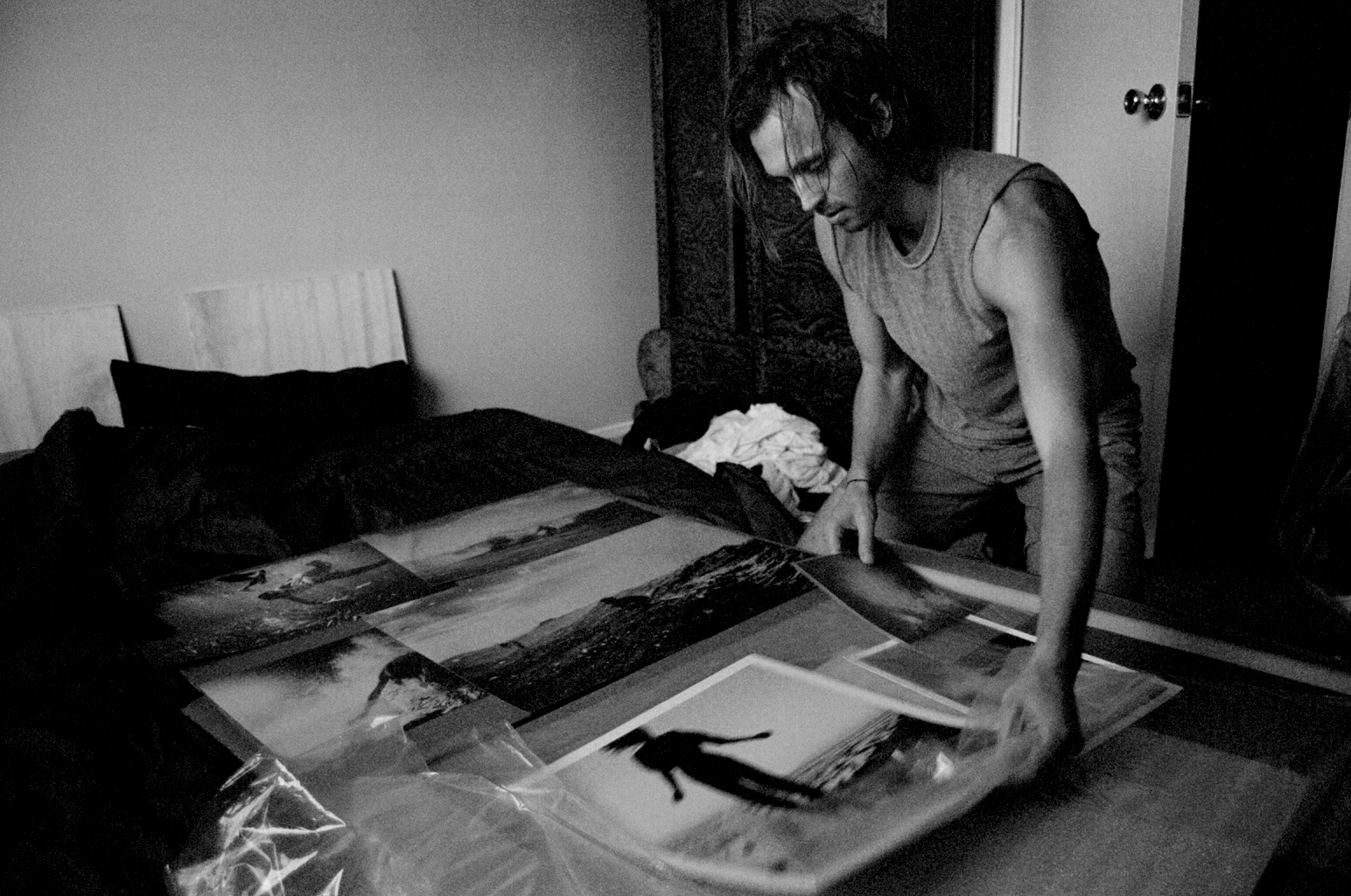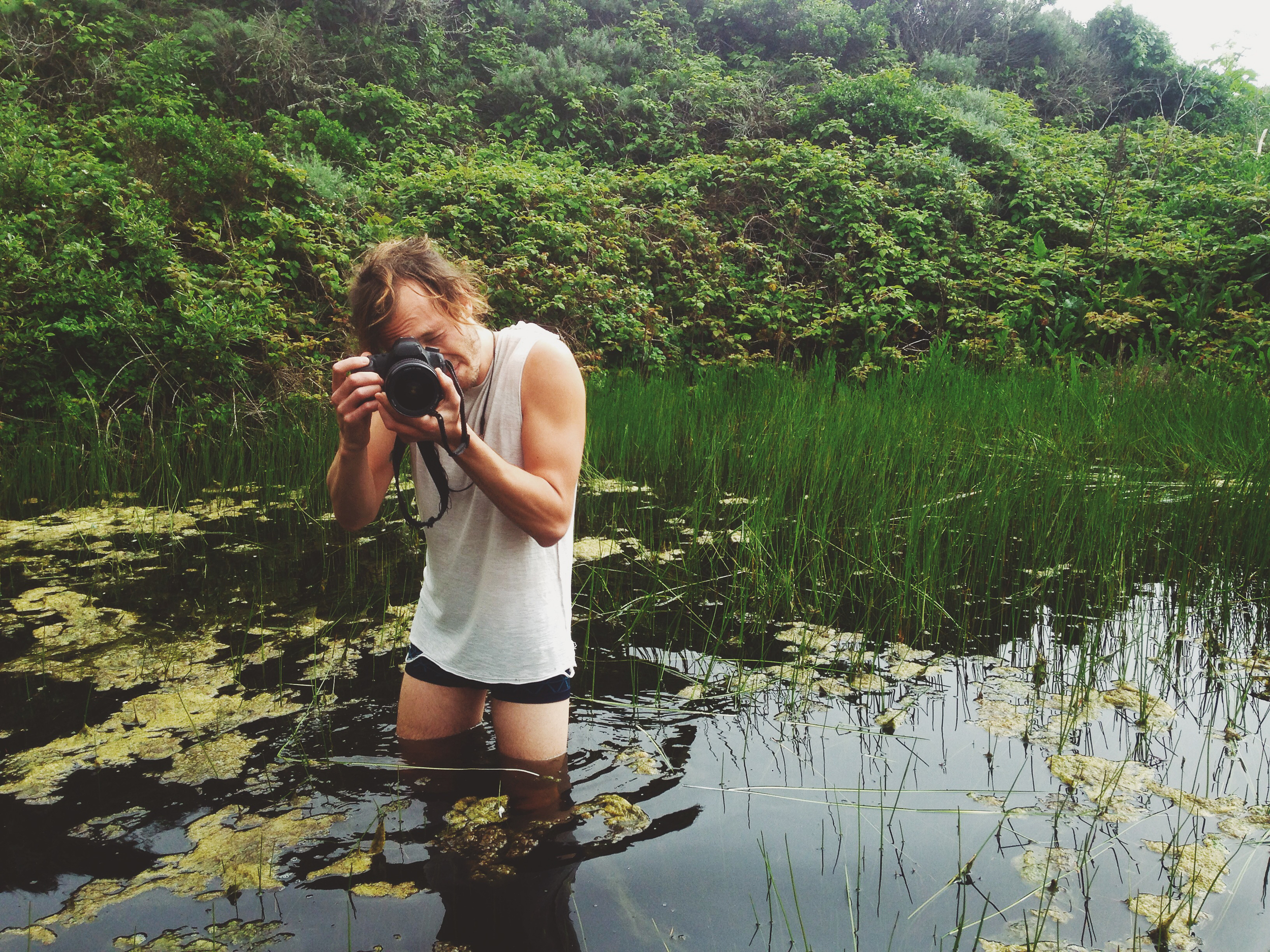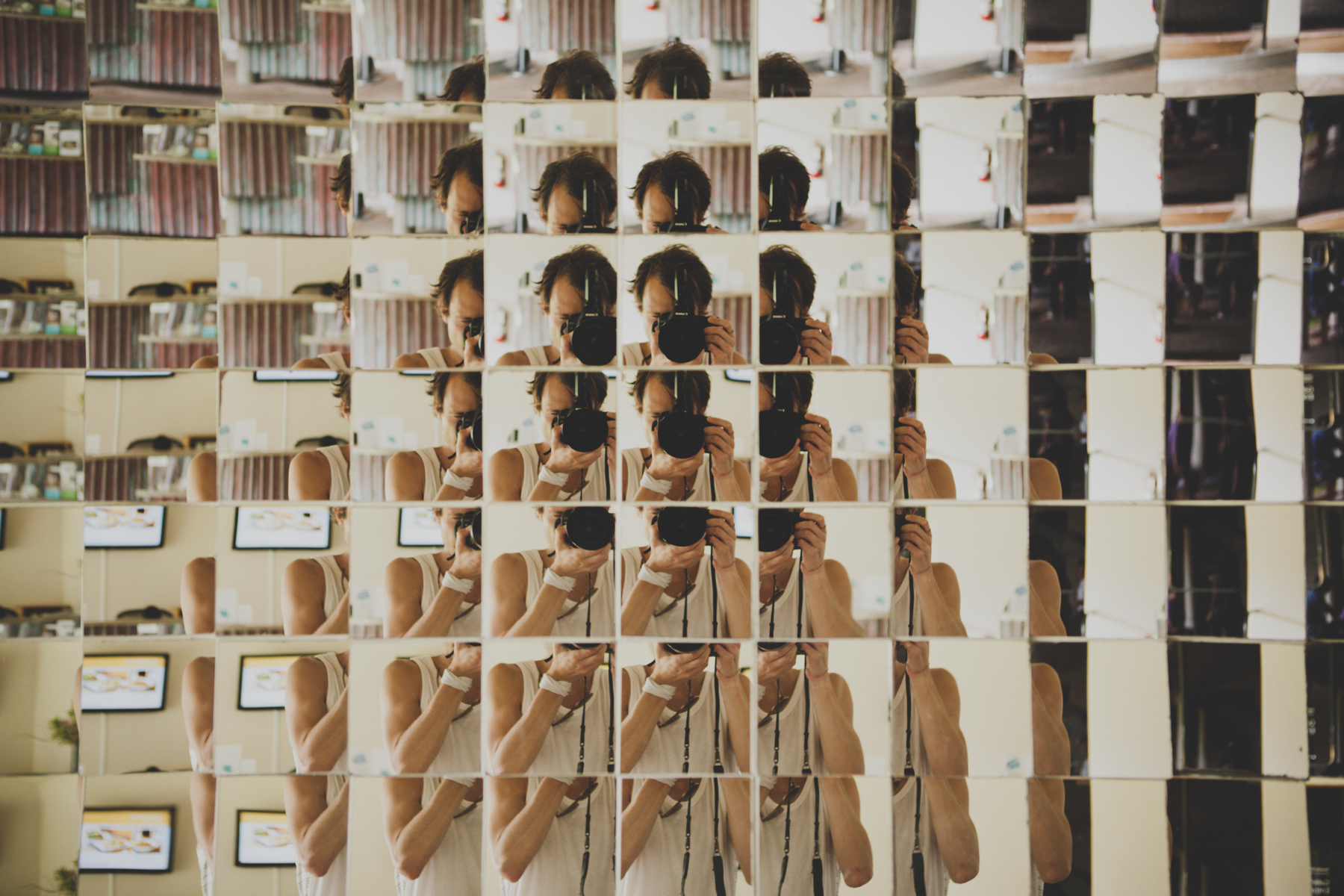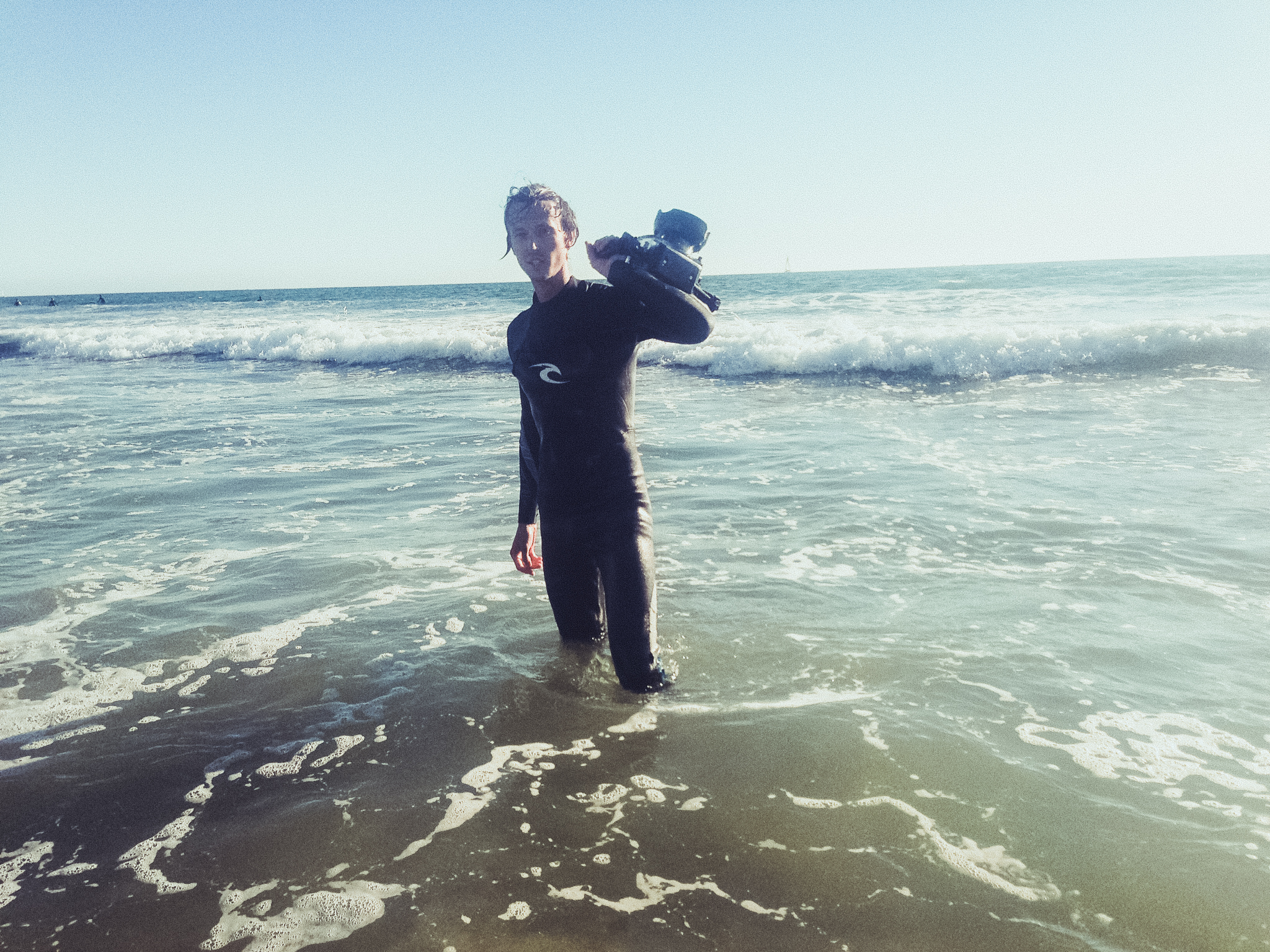Art Unified artist Daniel N. Johnson is part-time nomad and full-time sage, by way of 35 countries. What initially began as a means of sharing his experiences abroad with family and friends soon turned into a photographic aesthetic characterized by the most beautiful dualities: waxing and waning, inhaling and exhaling, ocean and desert. This masterful play on the emotional duplexity of his viewers is precisely the wonder of this artist: by submerging them into a foreign world of refracted light and disorienting darkness, his viewers emerge from each viewing at the height of awareness of the solid ground beneath their feet and a steady rhythm of breath. To capture the emotional shore between the world we know and how we'd like to know it is no easy task, but Johnson's grasp of ephemera and quick lens makes this transient meeting ground somehow seem, for a moment, inhabitable. Read on to see what Art Unified's favorite wayfarer had to say about Chuck Close, his disciplined morning routine, and hitchhiking between Poland and Turkey.
"I'm continually drawn to shoot either in water or the desert - for me both environments lend themselves to equal parts absence and fullness."
Art Unified: What drove you to want to become an artist?
Daniel N. Johnson: I think it’s because I wanted to share the way that I saw the world with others. That may be a clichéd a response as a photographer but it’s definitely one of my initial motivations - to find a way for other people to experience the beautiful or unique things I felt I discovered in life.
As an introverted and shy kid, visual expression was the easiest way for me to communicate. That pathway began in drawing, then led eventually to graphic and web design, motion graphics/animation, and now, photography.
It also became evident while traveling solo internationally. I’d have these incredible experiences which I felt slightly guilty to encounter all alone. I wanted to share my adventures with my friends and family and the camera became the most evident tool to do so, as well being as a wonderful vehicle to interact with other people.
AU: Are there aspects of the art world that you do not approve of? Did any of those reasons lead you to move towards Art Unified?
DNJ: I’m not much a fan of the generic art opening experience - white walls, white wine and the gathering of who’s who, where it’s more about the social event and posturing and less about the interaction or confrontation with the art. What I ultimately want to do is create an experience around the presentation of my art, where you can’t leave without being viscerally affected by it, and leave resonating with your reaction to the work.
I like that Art Unified is actively figuring out ways to put their artists’ work into public spaces where people who wouldn’t necessarily find themselves within the aforementioned white walls of a gallery can interact with new art.
AU: What was your first camera? Do you still use it today in your work, or do you prefer another setup?
DNJ: When I was maybe 7 or 8 my mom gave me a Vivitar 110 automatic film camera (one of those that look like an ice cream sandwich) so I could photograph my Legos. I photographed everything extremely close, imagining that I was capturing giant macro shots of my creations. However, the focal distance on the lens was about 2 or 3 feet so all my images came back as blurry messes. Maybe those were just my abstract years :)
In college I was studying graphic design but I needed a camera for a Photo 101 course. My uncle, who was a photojournalist and my initial photography mentor, gave me his old 35mm manual Nikon FM SLR. Unfortunately the camera broke several years later but I gave it back because it was very nostalgic for him.
I shoot mostly digital these days with a Canon 5D Mark II, but have recently been experimenting with medium format again - Hasselblad 500 series and a twin-lens reflex Seagull.
"When I was maybe 7 or 8 my mom gave me a Vivitar 110 automatic film camera so I could photograph my Legos. I photographed everything extremely close… however, the focal distance on the lens was about 2 or 3 feet so all my images came back as blurry messes. Maybe those were just my abstract years."
AU: What research has gone into the exploration of your artwork?
One of my main traits as a photographer, and probably as a person also, is an empathy for what is. I like to find my subject and potential locations and maybe give some direction but other than that I want to give minimal interference. Even though some of my work is slightly surreal I want it to still be honest - not manipulative, even in how I edit or process my imagery. I used Photoshop 5 years before I ever even took a photo class, so I knew how to create/manipulate other people’s images before I knew how to properly capture my own. As my experience with photography grew I tried to avoid any manipulation beyond the basics of color temperature/exposure/levels, etc
Initially everything starts with either my own experiences or the art I’ve been exposed to in the past. For me it’s more about the emotion I want to capture- so my research is a perpetual life search for reference or inspiration that speaks to that. It may be a quote, a piece of music, or a painting that conveys what I’m hoping to achieve.
AU: What are some of your favorite artists? How does your artwork relate and/or differ?
DNJ: My top three currently are James Turrell, Chuck Close and Ryan McGinley.
I love Turrell for how he explores light and forces his viewers to become more aware of their own perception - to see themselves seeing; the way that he makes us aware of light itself rather than just what light reveals. My own best images seem to usually have an element of that - the way that light reflects off my lens or on my subject, it takes on its own characteristic as a subject in the image and not just as the source of illumination. My early work especially had a lot of lens flare, shooting directly into the sun or other light sources. Turrell’s recent exhibition at LACMA was profoundly moving for for me and was a realization that I’d already been subconsciously exploring the same thing, albeit in a different medium.
I love the honest way that Close captures the human face and the essence of his subjects, very true to their flaws, to what is, but presented in a larger than life format. Staring into a face that's 6 or 7 feet tall forces you into a new relationship with his work. It’s both intimate and intimidating at the same time but ultimately it forces you to view the subject differently, and I think, to see yourself differently as well. I took some self-portraits a couple months ago to capture my own face in a close, uncomfortable large way, that filled the frame. We always want to present ourselves in a very idealized form and instead it forced me to present myself as I was, honestly in the moment. Anyway, Close’s inspiration is more aspirational - I want to make larger scale prints, to find a way to present vulnerabilities and flaws in a beautiful way. Also, whether he’s painting or photographing there is a continuity to his work as he deconstructs and reconstructs his subjects' visages.
And finally McGinley for how he captures a very raw human, energy in his subjects, he taps into the essence of youth and freedom- it’s a feeling that I attempt to capture and convey as well and thus I feel a kinship with him and with his work. He also appears to navigate seamlessly between commercial and personal work while maintaining his integrity as an artist, something that I admire.
AU: What is your studio or preferred place of work, what is it like working there?
DNJ: When I’m on the computer I need a visually quiet space. It’s difficult to work in coffee shops for example because there’s too much visual noise with people constantly moving about. I’ve been pretty nomadic the past few years so I’m still working on developing my ideal work setup - currently I work mostly from home and have a standup desk with an external monitor for my laptop and then everything else just gets spread out from there. I also like having indirect light, air-flow and plant or two to feel some life in the room.
My preferred place to shoot, however, is in a type of environment that is at the same time both contextual and context-less, so the desert or the ocean tend to be two places that continually draw me. I love shooting underwater because while you may be aware that you’re suspended in water, you’re still not quite sure what is happening. Or shooting in the desert, in a barren situation. In both places the light reflects and refracts differently and in sometimes unpredictable ways.
AU: Are there particular habits you have while you work?
DNJ: If I’m shooting it’s to make sure I’m well hydrated and have trail mix or an energy bar at hand. When I’m working on the computer I try to turn off my wi-fi and put my phone on airplane mode for one hour sessions to really get in the flow. I’m a bad multi-tasker and having internet access only exacerbates that if I get distracted.
I also try to be really aware of my breath. There’s a particular pattern that my breathing takes when I’m in the zone and focused. If my breathing is shallow it usually means I’m distracted and not present.
"I used to feel so paralyzed by the sheer amount of things I wanted to do in life - in college I had the wish that I could lead four separate lives simultaneously."
AU: What is one of your favorite quotes or piece of advice you have been given towards being an artist?
DNJ: “It’s not difficult to make things. What’s difficult is getting to the state where you can make things.” - Constantin Brançusi
AU: Did you ever think you would be anything else but an artist?
DNJ: I used to feel so paralyzed by the sheer amount of things I wanted to do in life. In college I had the wish that I could lead four separate lives simultaneously. The first was to follow the path of being a graphic designer, which is what I studied and ultimately began my career as. The second was to be a fine artist - a painter or printmaker. The third was to be a rockstar, and finally the fourth was to be something completely random like a shepherd in New Zealand, to have a very separate quiet introspective, almost monk-ish life.
However, I knew early on that I would work in a creative field of some sort. It may have taken me a while to take on the role of, or at least acknowledge myself as, an artist but from the age of 15 I knew I was going to be a graphic designer. Then I wanted to be a film director. Ultimately I landed in interactive design and motion graphics and out of that spun my current focus on photography.
AU: What has someone said about your artwork that resonates with you today?
DNJ: That I’m able to capture the essence of my subjects, enabling them to see themselves as they never have before. And to enable others to see the subjects as they never have before as well.
AU: How do you go about managing your time between your creative and personal life?
DNJ: There’s not much distinction - I’m always collecting inspiration, every book that I read or piece of music I listen to, every film or video I see, every conversation, etc. Most of my subjects are my friends. If I know you and we spend any amount of time together, the likelihood of you showing up in my art is very high.
That raises the question though - is art my life or is my life my art? I feel like all my life experiences are interpreted through the possibility of being part of something I eventually create. That mindset definitely helps for weathering difficult situations. For example, the best travel stories are usually the ones that weren’t the most pleasant at the time to experience.
However, when it comes to working, I’m a bit of a hermit if I get really focused. So when I try to separate my creative and personal lives, usually one or the other suffers. I can get too focused and only be working, or conversely I spend too much time hanging out with people and not enough time creating. The balance for me is usually found over a longer period of time rather than on a daily basis.
"Most of my subjects are my friends. If I know you and we spend any amount of time together, the likelihood of you showing up in my art is very high. That raises the question though - is art my life or is my life my art?"
AU: Have you taken part in a spiritual journey or means of travel to improve or change your perspective of art? What did you discover?
DNJ: Travel has been one of the most important influences of who I am as a person and consequently as an artist. From inspiring me to pick up a camera in the first place, to share my experience with others, to seeing the world as more than just my own felt experience. The majority of my travels have proved to me the interconnectedness of humanity, despite differences of culture, language, religion, etc.
After college I hitchhiked from Poland to Turkey, hitting about 17 countries in the process - a life-changing trip that forced me to confront a lot of my stereotypes and assumptions about other humans, as well as of myself and what I was capable of.
What I’m searching for in my photography is always something a bit ephemeral, attempting to discover or capture something that’s deeper than simply what is being shot or what is initially evident. From an artistic standpoint it’s about recognizing that the mountain is not "just a mountain” and the ocean is not “just the ocean’ but it’s the potential metaphor. . And in the same way I think that spirituality is also about awareness and perception, and the framework by which you interpret sensory input.
AU: What has your experience been with Art Unified? How did you get involved with Art Unified? How has your experience been with us so far?
DNJ: I first met Johan a little over a year ago at his Generation of War show. He had painted a portrait from a photo of mine that I’d taken in D.R. Congo shooting for Falling Whistles. Later that summer we crossed paths in Venice and he told me about his new business idea and asked me to submit a bio and some images - so I guess I was one of the original Art Unified artists, despite the fact that I dragged my feet a bit in finally submitting my work.
It’s been a great experience - Art Unified has consistently shown enthusiastic support for my work and were responsible for my first public showing in LA, helping me get some of my largest prints made to date.
AU: When you’re working, what does a typical day look like for you?
DNJ: I’m not a morning person but ironically the most consistent part of most days are my mornings. I wake up, do 15 mins of stretching and yoga, 20 minutes meditation, 75 pushups, make breakfast and coffee, then I try to write at least three pages in my notebook (a discipline I picked up from The Artist’s Way) all before I first check my phone or email.
After that I usually try to make a list of the things I need to do or intend to do during the day. Other than that, every day is different. Edits. Emails. Research. or shooting. I’ve gotten back into drawing again lately and usually try to make a minimum 5 drawings throughout the day as well.
AU: I’ve heard from Patrick and Johan that you travel often for your work. What are your favorite places to shoot, and is there a particular destination you’ve been hoping to shoot sometime in the near future?
DNJ: In spite of all my travels I don’t think I’ve shot or discovered my most favorite places yet. However, top on my list yet to visit are Mali, Iran, Madagascar, and Palau.
Two places I'm continually drawn to shoot in are either in water or the desert- for me both environments lend themselves to a equal parts absence and fullness. So living in Los Angeles, Venice Beach and Joshua Tree tend to be fairly consistent locations for me. But California is just an incredibly generous state in terms of it’s geographic diversity.
The past few years I've also spent a bit of time in Utah, which is also one of the most photogenic states in the U.S. I’ve done a lot of my underwater work in Central America. My favorite country though would have to be Ethiopia and I'm hoping to get back there later this year.
"What I ultimately want to do is create an experience around the presentation of my art, where you can’t leave without being viscerally affected by it, and leave resonating with your reaction to the work."







